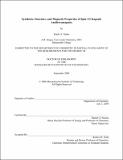Synthesis, structure, and magnetic properties of spin-1/2 kagomé antiferromagnets
Author(s)
Nytko, Emily A
DownloadFull printable version (27.49Mb)
Other Contributors
Massachusetts Institute of Technology. Dept. of Chemistry.
Advisor
Daniel G. Nocera.
Terms of use
Metadata
Show full item recordAbstract
Stoichiometrically pure S = 1/2 Cu2+ kagomé materials have been synthesized. Such materials provide an ideal venue for exploration of quantum states on a kagomé because they exhibit strong geometric spin frustration and are predicted to show no magnetic long-range ordering (LRO). The three broad classes of kagomé layered materials presented herein--covalently linked layers, hydrogen-bonded layers, and electrostatically linked layers--reflect optimization of structure to maximize frustration while simultaneously minimizing interlayer exchange to inhibit three-dimensional (3-D) LRO. The covalently linked layered system, Cu(1,3-benzenedicarboxylate), featuring in-plane monodentate [mu]-carboxylate bridges, is the first known structurally perfect S = 1/2 metal-organic framework (MOF) kagomé and bears the shortest metal-metal distance of any such material. The frustrated material features antiferromagnetic nearest-neighbor exchange (T = -33 K) but undergoes ferromagnetic ordering (Tc = 2 K), perhaps due to an out-of-plane spin polarization mechanism. The hydrogen-bonded layered system (CdCu3(OH)6(NO3)2.0.5H2O), featuring in-plane [mu]-hydroxy bridges, shows even stronger antiferromagnetic exchange (T = -114 ± 27 K), but still exhibits magnetic ordering behavior (Tc = 5 K), likely arising from interlayer exchange through hydrogen bonds. Electrostatically linked systems featuring in-plane [mu]-hydroxy bridges--the rare minerals claringbullite (Cu4(OH)xClyFz where x + y + z = 8), clinoatacamite (Cu2(OH)3Cl), and herbertsmithite (ZnCu3(OH)6Cl2)--have been prepared and characterized both structurally and magnetically. The former two minerals are frustrated systems but still show 3-D LRO arising from ferromagnetic interactions between the kagomé planes and interlayer copper(II) ions. Herbertsmithite, in contrast, features 2-D kagomé layers isolated by diamagnetic zinc(II) ions and exhibits no LRO to 50 mK, despite strong nearest-neighbor antiferromagnetic coupling (T = -314 K). Herbertsmithite displays no spin gap in its excitation spectrum at low temperature, a signature of a spin liquid phase with long correlations. (cont.) Continued efforts are directed at growth of large single crystals for probative neutron scattering studies. Current and future study of these stoichiometrically pure spin-frustrated systems will provide critical insight into the behavior of strongly correlated electrons.
Description
Thesis (Ph. D.)--Massachusetts Institute of Technology, Dept. of Chemistry, 2008. This electronic version was submitted by the student author. The certified thesis is available in the Institute Archives and Special Collections. Vita. Includes bibliographical references.
Date issued
2008Department
Massachusetts Institute of Technology. Department of ChemistryPublisher
Massachusetts Institute of Technology
Keywords
Chemistry.